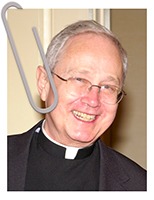A Niagara Faculty member seems to have anticipated a recent letter from the Superior General of the Congregation of the Mission urging Vincentians world-wide to renew and deepen their relationship with Vincentian Saints, Blessed, Venerable, and Servants of God of the Vincentian Family around the world as models of the Vincentian charism and spirituality.
In a recent article in the National Catholic Register, Saints You Should Know About, Kevin Di Camillo writes
One of the blessings of teaching at Niagara University, founded by the Vincentian Fathers, is that one is surrounded by buildings named after saints—and not surprisingly, more often than not, these saints are Vincentians.
Niagara’s central building is “Saint Vincent’s Hall” after the founder of the Lazarists (yet another name for the Vincentians), Saint Vincent de Paul. I’ve written about him here. The nearby De Marillac Hall is named after St. Louise de Marillac, his co-foundress of the Daughters of Charity.
He then goes on to explain other buildings on campus whose namesakes may not be as well-known.
St. Francis Regis Clet
But there are other buildings on campus whose namesakes are not as well-known. For example, Clet Hall was named for Saint Francis Regis Clet (pronounced “Clay”)… he sought and was granted permission to travel to China—that most impenetrable of anti-Christian countries—to bring the Good News.
Fr. Clet adopted the dress and mien of the locals, going so far as to grow a “Fu-Manchu” beard-and-moustache in order to embed himself in his adopted Chinese culture—a culture he lived in for three decades. From 1790-1820—nearly a full generation—Fr. Clet worked unceasingly to bring the Christian message to China…
St. Catherine Labouré
Also on Niagara’s campus is Laboure Hall, named after Saint Catherine Labouré (1806-1876), who was known the world over for her visions and the “Miraculous Medal.”
It’s been said that, until the Chaplet of Divine Mercy, no sacramental since the Holy Rosary itself had had such an immediate and far-reaching impact on the Church—and none had ever been diffused in such incredible numbers, with tens of millions of medal wearers all over the world…
St. John Gabriel Perboyre
Another building named for a Vincentian Saint is Perboyre Hall, after St. John Gabriel Perboyre, (1802-1840). Like St. Francis Regis Clet, St. John was a Frenchman who became a missionary to China. He followed both his brother, Louis, and his Uncle, Jacques, into the Congregation of the Mission….
The impact of a Niagra education on two future saints.
He concludes by pointing out that there is Our Lady of the Angels Chapel—the very chapel where two classmates, Ven. Nelson H. Baker and Ven. Michael McGivney (the founder of the Knights of Columbus)—prayed. Though they are not members of the Vincentians, they are alumni who are perhaps en route to canonization as I wrote of here.
[Kevin Di Camillo writes regularly for The National Catholic Register and is a Lecturer in English Literature at Niagara University. His latest book is Now Chiefly Poetical, and with Rev. Lawrence Boadt he edited John Paul II in the Holy Land: In His Own Words. His work has been anthologized in Wild Dreams: The Best of Italian-Americana, and he was awarded the Foley Poetry Prize from America Magazine. A graduate of the University of Notre Dame, he regularly attends Yale University’s School of Management Publishing Course.]


Rom 16, 13 reads: "Greet Rufus, chosen in the Lord; and greet his mother—a mother to me also." If this…
Have a blessed Holy Week!
I have never thought about the people that were named in the Gospels. I would agree that they may be…
Generally, I love the laconic nature of Mark's Gospel. The Passion narrative is very compelling in its starkness, with one…
Father John, Blessings to you as you step cautiously down that new path. Grace and Peace be with you!